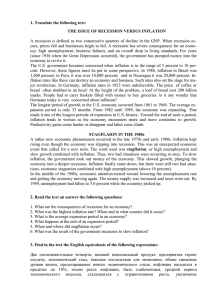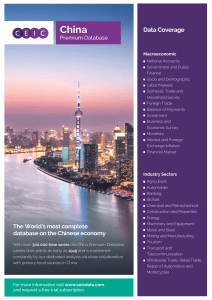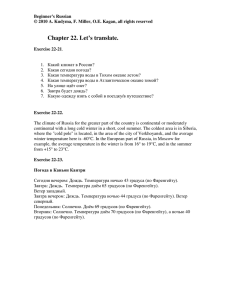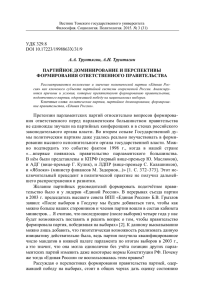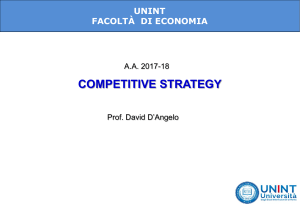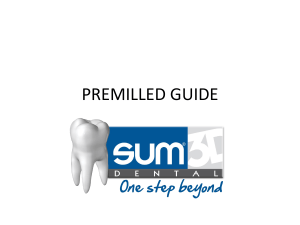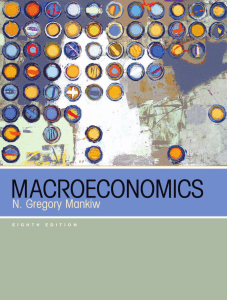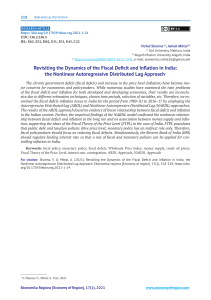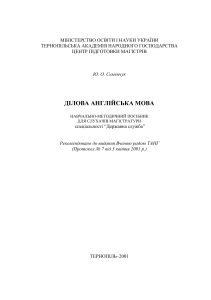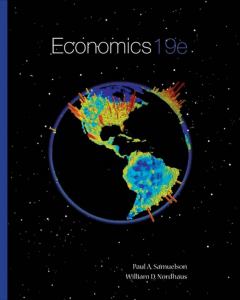Macroeconomics for economists
реклама
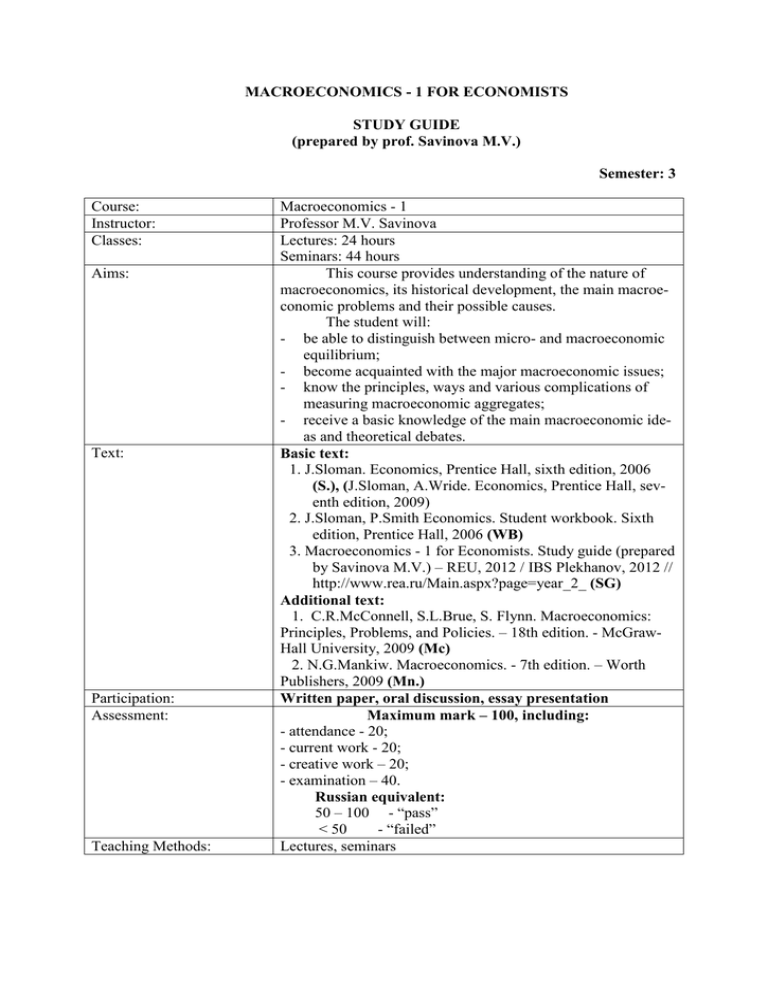
MACROECONOMICS - 1 FOR ECONOMISTS STUDY GUIDE (prepared by prof. Savinova M.V.) Semester: 3 Course: Instructor: Classes: Aims: Text: Participation: Assessment: Teaching Methods: Macroeconomics - 1 Professor M.V. Savinova Lectures: 24 hours Seminars: 44 hours This course provides understanding of the nature of macroeconomics, its historical development, the main macroeconomic problems and their possible causes. The student will: - be able to distinguish between micro- and macroeconomic equilibrium; - become acquainted with the major macroeconomic issues; - know the principles, ways and various complications of measuring macroeconomic aggregates; - receive a basic knowledge of the main macroeconomic ideas and theoretical debates. Basic text: 1. J.Sloman. Economics, Prentice Hall, sixth edition, 2006 (S.), (J.Sloman, A.Wride. Economics, Prentice Hall, seventh edition, 2009) 2. J.Sloman, P.Smith Economics. Student workbook. Sixth edition, Prentice Hall, 2006 (WB) 3. Macroeconomics - 1 for Economists. Study guide (prepared by Savinova M.V.) – REU, 2012 / IBS Plekhanov, 2012 // http://www.rea.ru/Main.aspx?page=year_2_ (SG) Additional text: 1. C.R.McConnell, S.L.Brue, S. Flynn. Macroeconomics: Principles, Problems, and Policies. – 18th edition. - McGrawHall University, 2009 (Mc) 2. N.G.Mankiw. Macroeconomics. - 7th edition. – Worth Publishers, 2009 (Mn.) Written paper, oral discussion, essay presentation Maximum mark – 100, including: - attendance - 20; - current work - 20; - creative work – 20; - examination – 40. Russian equivalent: 50 – 100 - “pass” < 50 - “failed” Lectures, seminars Course schedule Topic 1. Introduction to macroeconomics 2. Macroeconomic equilibrium I: aggregate demand/aggregate supply analysis. 3. Macroeconomic equilibrium II: the circular flow of income. 4. Macroeconomic issues I: economic growth and business cycles 5. Macroeconomic issues II: unemployment. 6. Macroeconomic issues III: inflation. Text Chapter S.13.1 (14.1); Mc.1; Mn.1 WB,Q.1(p.143); SG, Unit 1 S.14.2 (15.2); Mc.12; Mn.14 WB, Q.13 (p.153); SG, Unit 2 S.13.2 (14.2); Mc.2 WB.Q.6-8 (p.143-144); SG, Unit 3 S.13.4 (14.4); Mc.8,9; Mn.7, 8, 9 WB. Q. 20-24 (p.145); SG, Unit 4 S.14.1 (15.1); Mc.9; Mn.6 WB.Q.5,7,9 (p.151-152); SG, Unit 5 S.14.3 (15.3); Mc.9; Mn.4 WB.Q.17,18,23 (p.153-154); SG, Unit 6 Mid-term examination (test). 7. Measurement of national output and income. S.13.3 (14.3) + Appendix; Mc.7; Mn.2, 3 WB. Q.16, 17 (p.145), 34,35,38 (p.146-147); SG, Unit 7 8. Measurement of unemployment and S.14.1,14.3 (15.1,15.3); Mc. 7; Mn.2 inflation. WB.Q.1, 2 (p.151), 15,16 (p.153); SG, Unit 8 9. Background to money market 1: role S.17.1 (18.1); Mc.14; Mn.19 of money in the economy and money def- WB.Q.3 (p.185); SG, Unit 9 initions. 10. Background to money market 2: fiS.17.2 (18.2); Mc.14; Mn.19 nancial system and its functions. WB.Q.6-9,11-13 (p.186-187); SG, Unit 10 11. Macroeconomic ideas: classical mac- S.15 (16); Mc.10, 19 roeconomics, Keynesian revolution and WB.Q.1-5,7,14,15,19,22-24 (p.165-167); SG, modern development. Unit 11 Final examination. 3 Unit 1. Introduction to macroeconomics Check your understanding of the relevant terms, concepts and issues: macroeconomics (макроэкономическая теория), microeconomics (микроэкономическая теория), macroeconomic issues (макроэкономические проблемы), economic aggregates (совокупные, валовые экономические показатели), nominal and real variables (номинальные и реальные величины), short-run and long-run periods in the macroeconomics (краткосрочный и долгосрочный периоды в макроэкономическом анализе), endogenous variables (зависимые переменные), exogenous variables (независимые переменные). Topics for presentation (essay) 1. Who needs macroeconomics and what for? 2. Changes in the nominal and real incomes of my family. Questions for self-study (in written form) 1. The major macroeconomic issues: brief description. 2. Endogenous and exogenous variables in Macroeconomics: examples. Multiple choice, calculation, true/false 1. Macroeconomics is based on microeconomics for the following reasons: A. When we study the economy as a whole we must consider the decisions of individual economic agents. (True/False) B. Macroeconomic decision makers when they make their choices must maximize their total utility. (True/False) Explain your choice. 2. Which of the following indicators are economic aggregates? A. National output. B. Total utility. C. Aggregate supply. D. National idea. E. Overall level of prices. F. Overall education. Comment your choice. 3. Assume your family’s nominal income increases by 10% in the current year. What will be change in your real income if the current year inflation rate is 12%? 4. The following macroeconomic model is given: r r – average real interest rate (%); I – total amount of investment ($ bn). I I 4 A. What does this model show? B. Total investment is (endogenous / exogenous) variable. C. Business taxes rate is (endogenous / ex- ogenous) variable. D. How does increase in the business taxes rate affect total investment? Total investment curve? Show this change in the model. Topics for discussion and debate 1. Does ordinary housewife need some knowledge in Macroeconomics? Argue in favor of your opinion. 2. Should farmer in Tula region (Russia) know about changes in the Bank of Russia discount rate (interest rate on the Central Bank credit for commercial banks)? Unit 2. Macroeconomic equilibrium 1: aggregate demand / aggregate supply analysis Check your understanding of the relevant terms, concepts and issues: aggregate demand (совокупный спрос), consumer spending (потребительские расходы), investment (инвестиции), government spending (государственные расходы), net export (чистый экспорт), aggregate demand curve (кривая совокупного спроса), income and substitution effects in Macroeconomics (эффекты дохода и замещения в макроэкономике), non-pricelevel determinants of aggregate demand (неценовые факторы совокупного спроса), aggregate supply (совокупное предложение), aggregate supply curve (кривая совокупного предложения), three ranges of aggregate supply curve (три отрезка кривой совокупного предложения), non-price level determinants of aggregate supply (неценовые факторы совокупного предложения), macroeconomic equilibrium in AD-AS model (макроэкономическое равновесие в модели AD-AS), equilibrium price level (равновесный уровень цен), equilibrium real national output (равновесный уровень национального производства), the ratchet effect (эффект храповика). Topics for presentation (essay) 1. The structure of AD in Russia: current situation and tendencies. 2. Does the ratchet effect take place in Russia? Questions for self-study (in written form) 1. The short-run aggregate supply curve. 2. The long-run aggregate supply curve. Multiple choice, calculation, true/false 1. The following data are given (in $ bn): Total consumers’ expenditure 300 Government final consumption 90 Gross domestic fixed capital formation 70 Exports of goods and services 100 Imports of goods and services 130 Calculate the size of aggregate demand. 2. Which of the following events would most likely decrease aggregate demand (ceteris paribus)? A. A reduction in the excess capital of the existing capital stock. 5 B. A reduction in business and personal tax rates. C. National currency depreciation. D. An increase in personal income tax rates. E. A construction of new road by local authorities. 3. Which of the following events would most likely increase aggregate supply (ceteris paribus)? A. An increase in the prices of imported raw materials. B. An increase in productivity of labour. C. A decrease in business subsidies. D. A decrease in net export. E. An increase in power of trade unions. 4. An increase in business taxes would tend to: A. increase aggregate demand and decrease aggregate supply; B. increase aggregate demand and increase aggregate supply; C. decrease aggregate demand and increase aggregate supply; D. decrease aggregate demand and decrease aggregate supply; E. no changes in both aggregate demand and aggregate supply. 5. The following model of aggregate demand/aggregate supply is given in the table below: Amount of real national output demanded ($ bn) 100 200 300 400 400 Price level (price index) 300 250 200 150 150 Amount of real national output supplied ($ bn) 400 400 300 200 100 a) Draw aggregate demand and aggregate supply curves. Determine the equilibrium real national output and equilibrium price level. b) Assume government spends additional $ 200 bn at each price level. Calculate a new equilibrium national output and equilibrium price level. Use a graph to show this change. 6. If aggregate demand decreases and as a result real national output decreases but the price level remains unchanged, we can assume that aggregate demand curve intersects aggregate supply curve in the (Keynesian, intermediate, classical) range of aggregate supply curve. Illustrate your answer graphically. Topics for discussion and debate 1. Is AD curve elastic in Russia? Argue in favor of your opinion. 2. Try to explain the modern tendencies in the Russian economy (moderate economic growth and insufficient increase in price level) using aggregate demand/aggregate supply analysis. 6 Unit 3. Macroeconomic equilibrium 2: the circular flow of income Check your understanding of the relevant terms, concepts and issues: circular flow of income model (модель кругооборота доходов), inner flow of income model (модель внутреннего кругооборота доходов), factor payments (плата за факторы производства), spending on consumption (затраты на покупку отечественных потребительских товаров и услуг), full circular flow of income model (полная модель кругооборота доходов), net saving (чистые сбережения), net taxes (чистые налоги), import expenditure (расходы на импорт), withdrawals (изъятия из внутреннего кругооборота доходов), investment (инвестиционные расходы), government expenditure (государственные выплаты фирмам и домохозяйствам), export expenditure (доходы от экспорта), injections (вливания во внутренний кругооборот доходов). Topics for presentation (essay) 1. Households saving in Russia: specific features and trends. 2. Export / import relationship in Russia and its influence on economic growth. Multiple choice, calculation, true/false 1. Which of the following are included in the net saving in the circular flow of income model? A. Cash in your pocket which was not spent over a given period. B. Cash deposited in the bank on the demand and time accounts. C. Withdrawals of the households’ past saving from the banks. D. Diamonds kept in the bank safe. E. Money in the buried treasure. 2. Which of the following are considered to be investment in Macroeconomics? A. Borrowing money by consumers for purchasing new cars. B. Purchase of the company’s shares. C. Expenditure on the new office computer. D. Consumer expenditure on the new private house construction. E. Deposits in the Investment Bank. F. Purchase of the paper for office needs. 3. In the circular flow of income model government expenditure includes: A. Policemen salary; (yes / no) B. Expenditure on the municipal school building; (yes / no) C. Government subsidies to new road construction; (yes / no) D. Government contribution to the Pension Fund; (yes / no) E. Government investment in the public corporation; (yes / no) F. Government accounts in the Central Bank. (yes / no) 4. “Export means outflow of goods and services whereas import is inflow of goods and services. That’s why export is a component of withdrawals whereas import is a component of injections in the circular flow of income model” (True / False). Explain your answer. Topics for discussion and debate 1. What are the positive effects of budget deficit (G>T) and negative effects of budget surplus (T>G)? 7 2. Does balance of payments surplus (when X>M) always desirable? Unit 4. Macroeconomic issues 1: economic growth and business cycles Check your understanding of the relevant terms, concepts and issues: rate of economic growth (темпы экономического роста), actual growth (реальный рост), potential growth (потенциальный рост), production possibility curve and economic growth (кривая производственных возможностей и экономический рост), sources of economic growth (источники экономического роста), Solow growth model (модель роста Солоу), business (trade) cycles (деловые циклы), phases of business cycle (фазы делового цикла): upturn, trough (низшая точка делового цикла), boom, recovery, expansion (оживление, подъем), peaking out, peak (пик делового цикла), slowdown, recession, slump (спад, застой), noncyclical fluctuations (нециклические колебания), sunspot cycle theory (теория солнечных пятен), psychological cycle theory (психологическая теория цикла), political business cycle theory (теория политического делового цикла), the theory of innovations (теория инноваций), Keynesian trade cycle theory (кейнсианская теория делового цикла). Topics for presentation (essay) 1. Benefits and costs of economic growth for Russian economy. 2. Causes and specific features of the 2008 world recession. Questions for self-study (in written form) 1. Actual output, potential output and output gap. 2. Theories of economic growth. Multiple choice, calculation, true/false 1. Suppose that capital’s share in national income is 0.3 and labor share is 0.7 and annual growth rate of capital and labor are 5 and 1 percent, respectively. Assume there is no technical change. a) At what rate does output grow? b) Now suppose technology growth at a rate 2%. Recalculate your answer. 2. Suppose output is growing at 2% per year and capital’s and labor’s shares of income are 0.4 and 0.6 respectively. If both labor and capital grow at 1% per year, what would the growth rate of total factor productivity have to be? 3. In what of the following industries is output least (and in what – most) likely to be affected by the business cycle? A. Housing construction. B. Automobile production. C. Agricultural production. D. Capital goods production. Explain your answer. 4. Russian economy is currently in the: A. peak phase of the business cycle; B. recession phase; C. trough phase; D. recovery phase; E. slowdown phase 8 Argue in favor of your opinion. Answer this question again assuming USA economy, EU economy, Japan economy. Topics for discussion and debate 1. “Potential growth is impossible because increase in the quantity of resources causes diminishing returns. Thomas Malthus was right”. Do you agree? Comment your opinion. 2. Which of the business cycles theories may be used to explain current business fluctuations in Russia? Argue in favor of your opinion. Unit 5. Macroeconomic issues 2: unemployment Check your understanding of the relevant terms, concepts and issues: rate of unemployment (уровень безработицы), natural (full-employment, equilibrium) rate of unemployment (естественная, равновесная безработица), aggregate demand for labour curve (кривая совокупного спроса на рабочую силу), aggregate supply of labour curve (кривая совокупного предложения рабочей силы), labour force curve (кривая рабочей силы), frictional (search) unemployment (фрикционная безработица), structural unemployment (структурная безработица), technological unemployment (технологическая безработица), regional unemployment (региональная безработица), seasonal unemployment (сезонная безработица), disequilibrium unemployment (неравновесная безработицы), real-wage (classical) unemployment (классическая безработица), wage inflexibility or rigidity (негибкость заработной платы), cyclical (demand-deficient) unemployment (циклическая безработица), costs of unemployment (издержки безработицы), underproduction or GDP gap (недопроизводство ВВП), Okun’s law (закон Оукена). Topics for presentation (essay) 1. Benefits and costs of unemployment for Russian economy. 2. Equilibrium (natural) and disequilibrium unemployment in Russia. Questions for self-study (in written form) 1. Reasons and factors of structural unemployment. 2. Technology and employment. Multiple choice, calculation, true/false 1. The following model of aggregate labor market is given: 9 Real average wage rate ASL N 6 4 AD L ADL1 Number of workers 20 50 55 30 35 Assume ASL and ADL are initial aggregate supply of labor curve and aggregate demand for labor curve, respectively, N is labor force curve and wages are perfectly inflexible. Assume also that economy is in the recession and, as a result, ADL curve shifts to the left in the ADL1 position. Determine: a) the size of equilibrium unemployment; b) the size of disequilibrium unemployment 2. How the following changes would affect the natural rate of unemployment? A. Elimination of unions. B. Increased participation of women in the labor market. C. Larger fluctuations in the level of aggregate demand. D. Increase in unemployment benefits. E. Elimination of minimum wages. F. Changes in the composition of aggregate demand. 3. Assume that in a given year natural rate of unemployment is 5%, actual rate of unemployment is 9%. What is the GDP gap (in percent)? Topics for discussion and debate 1. Why is aggregate supply of labor curve inelastic and labor force curve more inelastic than aggregate supply of labor curve? 2. What type of unemployment dominates in Russian economy? Comment your opinion. 3.”Wages in Russia are highly inflexible”. Do you agree? Argue in favor of your opinion. 4. What are the possible benefits from unemployment for economy? For unemployed people? 10 Unit 6. Macroeconomic issues 3: inflation Check your understanding of the relevant terms, concepts and issues: inflation (инфляция), creeping (moderate) inflation (умеренная инфляция), galloping inflation (галопирующая инфляция), hyperinflation (гиперинфляция), anticipated (expected) inflation (прогнозируемая инфляция), unanticipated (unexpected) inflation (непрогнозируемая инфляция), demand-pull inflation (инфляция спроса), inflation of boom (инфляция бума), pure inflation (чистая инфляция), cost-push (supply-side) inflation (инфляция издержек), inflation of recession (инфляция спада), wage-price spiral (спираль «заработная плата – цены»), inflationary expectations (инфляционные ожидания), nominal (money) income (номинальный доход), real income (реальный доход), nominal interest rate (номинальная ставка процента), real interest rate (реальная ставка процента), Fisher effect (эффект Фишера), shoe-leather costs (издержки стоптанных башмаков), menu costs (издержки меню). Topics for presentation (essay) 1. Specific features of inflation spiral in Russia. 2. Costs of inflation for my family. Can we benefit from inflation? Questions for self-study (in written form) 1. Hyperinflation: historical examples 2. Policies to tackle inflation. Multiple choice, calculation, true/false 1. What type of inflation (demand-pull or cost-push) will occur as a result of (ceteris paribus): A. a rise in government expenditures on military needs; B. an increase in the consumer spending as a result of population boom; C. an increase in the monopoly power of trade unions; D. an increase in the monopoly power of firms; E. a decrease in the productivity of labor 2.”Pure inflation is represented by persistent shift of aggregate demand curve to the right (when aggregate supply remains unchanged) in the Keynesian range of aggregate supply curve” (True / False). Illustrate your answer graphically. 3. What will happen with the average real wages if increase in the average nominal wages is 15% and increase in the price level is 18%? 4. Assume the real average interest rate is 5% and the rate of inflation is 3%. Calculate the nominal average interest rate. 5. How does an unanticipated inflation influence real incomes of the following persons: A. Old man, the former worker. B. Clerk. C. Worker – membership of the powerful trade union. D. Farmer with the great indebtedness. E. Retired manager whose income consists of only interest from government bonds. F. Shopkeeper in the small town. Topics for discussion and debate 11 1. How could you characterize current inflation in Russia in accordance with its types? 2. Is it possible to fight inflationary expectations in Russia? What government should do? Unit 7. Measurement of national output and income Check your understanding of the relevant terms, concepts and issues: Gross Domestic Product (Валовой Внутренний Продукт), domestic and foreign residents (резиденты и нерезиденты данной экономики) final output (конечная продукция), intermediate output (промежуточная продукция), value added (добавленная стоимость), transfer payments (трансфертные платежи), non-production transactions (непроизводительные сделки), stock appreciation (инфляционное удорожание запасов), Gross National Income (Валовой Национальный Доход), net income from abroad (чистый доход от собственности за рубежом), Net Domestic Product (Чистый Внутренний Продукт), Net National Income (Чистый Национальный Доход), depreciation (амортизация), three ways of calculating GDP: product method (output approach), income method (earnings, allocation approach), expenditure method or approach (три способа расчета ВВП: производственный метод, метод доходов и метод расходов), nominal national income (номинальный национальный доход), real national income (реальный национальный доход), GDP deflator (дефлятор ВВП), GDP per capita (ВВП на душу населения), non-market activities (нерыночная деятельность), underground economy (теневая экономика), non-monetary indicators of living standard (нерыночные показатели уровня жизни) Topics for presentation (essay) 1. GDP accounting in Russia. 2. The factors that determine the size of the underground economy in Russia. 3. The influence of the underground economy on the welfare and living standard of my family. Questions for self-study (in written form) 1. Calculation of Personal Disposable Income. 2. Items included in GDP: product method, income method. 3. An index of sustainable economic welfare (ISEW): an alternative to GDP? Multiple choice, calculation, true/false 1. A business buys $ 6000 worth of material resources to produce a product. The business makes 100 units of the product and each of them sells for $ 70. Calculate the value added. 2. Which of the following statements about GDP accounting are correct? A. The value of corporate stocks and bonds traded in a given year is included in the calculation of gross private domestic investment. B. GDP excludes expenditures by business on pollution control equipment. C. GDP excludes expenditures by consumers on used cars. D. Money spent on the purchase of a new house is included in the GDP as a part of personal consumption expenditure. E. The monthly allowance which a IBS student receives from parents is included in GDP. F. The service of a painter in painting his/her own house is not included in GDP. G. A 2-hour decline in the length of the work week is directly included in GDP. H. An increase in business inventories is included in GDP. 12 I. The market value of a housewife’s services is included in GDP. 3. The following national income data are given ($ bn): Capital consumption allowance Indirect business taxes Compensation of employees Rents Net interest Mixed incomes Corporate net profits Dividends Undistributed corporate profits Personal consumption expenditures Gross private domestic investment Government purchases of goods and services Net export Determine: a) GDP calculated with income approach; b) GDP calculated with expenditure approach; c) Net Domestic Product; d) Net private domestic investment. 400 330 2400 20 300 250 90 80 150 2600 700 800 -80 4. The following data are given ($ bn) and year 1 is the base year: Year 1 2 3 4 Nominal GDP 3200 3400 3700 4000 GDP deflator 100 102 106 112 Determine: a) real GDP in year 4; b) real GDP increased from year 3 to year 4 by ___bn 5. What would be the most likely effect on real GDP and living standard of each of the following: A. An increase in the workweek from 40 hours to 50 hours for every industrial worker. B. The legalization of prostitution presently undertaken in the underground economy. C. A $ 1 ml increase in the production of condoms offset by a $ 1 ml decline in child benefits. Topics for discussion and debate 1. Does Russian GDP statistics understate or overstate our real living standard? Argue in favor of your opinion. 2. How to restrict underground economy in Russia? What government should do? Unit 8. Measurement of unemployment and inflation Check your understanding of the relevant terms, concepts and issues: unemployment rate (уровень безработицы), labour force (численность рабочей силы), unemployed people (безработные), claimant unemployment (заявленная безработица), standardized unemployment rate (стандартизированный уровень безработицы), underemployment (частичная безработица), hidden (disguised) unemployment (скрытая безработица), dura- 13 tion of unemployment (продолжительность безработицы), stock of unemployment (размер безработицы), inflow in and outflow from the stock of unemployment (приток и отток из состава безработных), composition of unemployment (структура безработицы), producer price index (индекс цен производителей), export price index (индекс экспортных цен), import price index (индекс цен импорта), consumer (retail) price index (индекс потребительских цен), rate of inflation in a given year (темпы инфляции в данном году). Topics for presentation (essay) 1. Composition of unemployment in Russia. 2. Minimum consumer basket in Russia and real people needs. Questions for self-study (in written form) 1. Inflows and outflows from the stock of unemployment. 2. Duration and composition of unemployment. Multiple choice, calculation, true/false 1. The unemployment rate in economy is 8%. Labor force is 50 millions. What is the number of employed people in the economy? 2. What will be the unemployment rate if the total population is 200 millions, the labor force is 150 millions and 120 millions workers are employed? 3. Suppose only bananas and oranges are produced in the economy and bananas cost $ 0.5 in 1995 and $ 1 in 2005 while oranges cost $ 1 in 1995 and $ 0.5 in 2005. If 10 tons of bananas and 5 tons of oranges were produced in 1995 while 5 tons of bananas and 10 tons of oranges were produced in 2005, what is the CPI for 2005 using 1995 as the base year? 4. The CPI was 250 in year 1 and 260 in year 2. What was the rate of inflation in year 2? 5. The figures below show the price index in the economy at the end of four different years: Year 1 2 3 4 Price index 100 110 125 130 A. Calculate the rates of inflation in years 2, 3 and 4. B. Using the “rule of 70” how many years would it take for the price level to double at each of these three inflation rates? Topics for discussion and debate 1. Does Russian statistics underestimate or overestimate the real rate of unemployment? Argue in favor of your opinion. 2. What is better for the economy (and for unemployed people): 3% unemployment with average duration 1 year or 12% unemployment with an average duration 3 months? 3.”Hidden unemployment is greater in the planned economy than in the market economy”. Do you agree? Argue in favor of your opinion. 4. Inflation accounting in Russia: does it reflect the real changes in the price level? Unit 9. Background to money market 1: role of money in the economy and money definitions 14 Check your understanding of the relevant terms, concepts and issues: functions of money: medium of exchange, measure of value or means of evaluation, storing wealth, means of future payments (функции денег: средство обращения, мера стоимости, накопления богатства, кредитные деньги), value of money (стоимость денег), narrow definitions of money (узкое определение денег), liquidity (ликвидность), cash (наличность), till money (кассовые деньги), sight (demand, checkable) deposits (вклады до востребования), broad definitions of money (широкое определение денег), near money (почти деньги), large time (wholesale) deposits (крупные срочные вклады), government bonds (государственные облигации), treasury bills of exchange (казначейские векселя), rate of discount (дисконтная ставка по векселям). Topics for presentation (essay) 1. Who buys government securities in Russia and what for? 2. Money aggregates accounting in Russia. Questions for self-study (in written form) 1. Functions of money. 2. UK and Eurozone monetary aggregates. Multiple choice, calculation, true/false 1. Which of the following items are considered to be money? A. Gasprom shares. B. Gold. C. Government bonds. D. Credit cards. E. Demand deposits. F. Savings deposits. G. Wholesale deposits. 2. Which of the following constitutes the largest element in the money supply? A. Currency. B. Banknotes. C. Time deposits. D. Demand deposits. E. Coins. 3. Which of the following financial assets are most (and least) liquid in Russia? A. Cash. B. Retail deposits in commercial banks. C. Wholesale deposits in Sberbank. D. Flat in Moscow. E. 2005 Ford. F. Diamonds. 4. The price of bond is originally $ 5000 and it pays an annual interest payment of $ 500. What will be interest rate of bond if the price of bond falls to $ 4000? 5. What is the face value of bill if it was sold for $ 270 at 10% of discount rate? Topics for discussion and debate 15 1. “In order to prevent monetary problems we should return to the gold standard system”. Do you agree? 2. Identify problems connected with the expansion of credit cards in Russian economy. Unit 10. Background to money market 2: financial system and its functions Check your understanding of the relevant terms, concepts and issues: financial sector (финансовый сектор экономики), Central Bank (Центральный Банк), commercial banks (коммерческие банки), savings (thrift) institutions (сберегательные финансовые институты), bank’s balance sheet (банковский баланс), assets (активы), liabilities (пассивы), vault cash (кассовые деньги), required (statutory, minimum) reserves (обязательные резервы), required reserve ratio (норма обязательных резервов), excess reserves (избыточные резервы), actual reserves (общие резервы), short-term loans (краткосрочные кредиты), longer-term loans or advances (долгосрочные кредиты), certificates of deposits (сертификаты депозитов), repos (договор о продаже и выкупе банковских активов), profitability (прибыльность), liquidity or safety (обеспечение ликвидности), liquidity ratio (норма ликвидности), Central bank’s functions (функции Центрального банка). Topics for presentation (essay) 1. Specific features of the financial system in Russia. 2. Central Bank of Russia as a supervisor of financial institutions’ activity. 3. Liquidity crisis in the USA (2007): causes and effects. Questions for self-study (in written form) 1. The role of financial sector. 2. Parallel money market. Multiple choice, calculation, true/false 1. Which of the following are functions of financial institutions? A. Profit maximization. B. Risk of lending taking. C. Provision of long-run credits. D. Operations with shares and bonds. E. Distribution of financial resources. 2. Assume bank’s excess reserves are $ 8000 and demand deposits are $ 150000. What will be actual reserves if required reserve ratio equals 20%? 3. A bank is in the position to make loans when required reserves: A. equal actual reserves; B. are less than actual reserves; C. are greater than actual reserves; D. equal statutory reserves 4. A single commercial bank must meet a 25% reserve requirement. If it initially has no excess reserves and then $ 2000 in cash is deposited in the bank, it can increase its loans by a mximum of ______. 16 5. Profitability is (true/false): A. the only aim of each bank; B. one of the aim of each bank; C. the main aim of traditional business; D. determined mainly by the bank’s net interest; E. determined mainly by the profits from the speculation with securities. Topics for discussion and debate 1. Do commercial banks in Russia fulfill all functions of the financial institutions completely? 2. Discuss: “Deregulation of financial sector is one of the main reason of the liquidity crisis (2007)”. Unit 11. Macroeconomic ideas: classical macroeconomics, Keynesian revolution and modern development Check your understanding of the relevant terms, concepts and issues: classical theory (классическая теория), Keynesian revolution (Кейнсианская революция в теории), government economic intervention (государственное вмешательство в экономику), gold standard system (система золотого стандарта), Say’s law (закон Сэя), deficiency of aggregate demand (недостаточность совокупного спроса), quantity theory of money (количественная теория денег), equation of exchange (количественное уравнение обмена), velocity of circulation of money (скорость обращения денег), Monetarism (монетаризм), Rational Expectations Theory (теория рациональных ожиданий), demandmanagement policies (политика манипулирования совокупным спросом), Topics for presentation (essay) 1. Keynesian recommendations and the modern economic policies in Russia. 2. Velocity of money circulation in Russia. 3. Monetarist ideas in the beginning of the market reforms in Russia. Questions for self-study (in written form) 1. Monetarist counter – revolution. 2. The rational expectations revolution. Multiple choice, calculation, true/false 1. Long-run disequilibrium of the markets and laissez-faire policy are the main ideas of classical economics (True/False). Explain your answer. 2. In the classical theory, if saving exceeds investment the rate of interest will rise until saving and investment are equal (True/False). Illustrate your answer graphically. 3. Keynesians argue that AS curve is elastic, aggregate supply is determined by changes in aggregate demand and aggregate demand is stable. (True/False) 4. Keynesians argue that only disequilibrium unemployment exists because prices and wages are inflexible (True/False). 17 5. The following relationship between price level and real national output is given: Price level 1 2 3 4 5 6 7 Real national output 100 110 120 130 140 150 160 Assume velocity of money circulation is stable and equal 4, money supply is $ 90 bn. a) Calculate nominal equilibrium national output, equilibrium price level and real national output. b) Recalculate a) assuming increase in money supply to $ 175 bn. Topics for discussion and debate 1. “High wages increase costs of production and as a result lead to increase in unemployment and decrease in business activity”. Do you agree? Argue in favor of your opinion. 2. Do you personally behave rationally? Your friends? Your grandmother? 3. Which of the RET ideas seem to you most reasonable, and which of them – least reasonable? Questions for examination 1. Introduction to macroeconomics: the major macroeconomic issues and specific features of macroeconomic analysis. 2. Aggregate demand and aggregate demand curve. 3. Aggregate supply, aggregate supply curve and its three ranges. 4. Non-price-level determinants of aggregate demand and aggregate supply. 5. Macroeconomic equilibrium in the AD / AS model. 6. Macroeconomic equilibrium in the circular flow of income model. 7. Economic growth and its sources. 8. Business cycle: phases and causes. 9. Equilibrium (natural) unemployment and its types. 10. Disequilibrium (natural) unemployment and its types. 11. Costs of unemployment. 12. Inflation: definition and classifications. 13. Demand-pull and cost-push inflation 14. The role of expectations in the inflationary process. 15. Measurement of national income: GDP and three methods of its calculation. 16. Measurement of unemployment: indicators and problems. 17. Measurement of inflation: consumer price index and inflation rate. 18. Money: nature and functions. 19. Narrow and broad definitions of money. 20. Financial system: structure and functions. 21. Bank’s activity: the simplified bank balance sheet. 22. Two aims of bank’s activity and the conflict between them. 23. Central Bank and its functions. 24. Classical economics, Keynesian revolution and modern development of macroeconomic theory. 25. The main areas of disagreement between classical and Keynesian economics. 18

